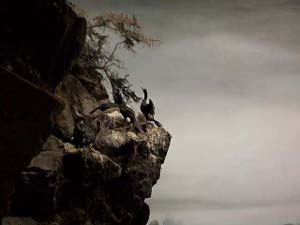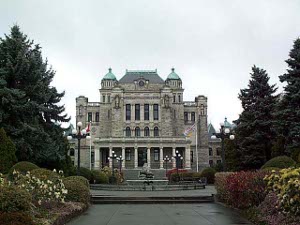 HMS Discovery
HMS Discovery
The Royal British Columbia Museum in Victoria occupies an impressive glass-fronted building in Victoria's Inner Harbour tourist center, between the Empress Hotel and the Parliament building. It has three very tall floors: the first is given over to the Imax theater, the cafeteria and gift shop; the second is natural history and the third is First People and modern history.
 HMS Discovery
HMS Discovery
Throughout the museum the curators have taken advantage of the height of the floors by using multi-level displays; one is constantly turning a corner and encountering stairs to another level. This provides considerable architectural interest, and makes walking through the museum somewhat like going through a display at a modern theme park.
The First Nations galleries are filled with lavish displays of masks, carvings in wood and argilite, decorated chests, textiles and buildings, plus a couple of the large canoes made from cedar trees. The Modern History area is also bountifully furnished with everything from old sea-faring equipment to sample rooms furnished in 19th-century style. Captain Vancouver's stateroom in the Discovery has been re-created, in surroundings which reminded us, rather unfortunately, of Disneyland's Pirates of the Caribbean.
The function of a museum should be to educate; the best educational display on the third floor was the 20th century British Columbia history, which had a story board for each decade. We're interested in learning more about the Doukhobors, a fundamentalist Russian Christian sect that was exiled to Canada by  Historical Exhibit
the Czar. Although the Doukhobors are avowedly pacifist, one splinter group was convicted of arson in the 1950s.
Historical Exhibit
the Czar. Although the Doukhobors are avowedly pacifist, one splinter group was convicted of arson in the 1950s.
We also learned that Japanese, Chinese and East Indian citizens were allowed Canadian voting rights in the late 1940s.
It makes us feel very old to see a lot of the 20th century "artifacts" which we grew up with on display as museum pieces!
On the second floor, we went into a special exhibit on undersea exploration. We joined a small group to see, in order, a hokey pseudo-newsreel about a "Dr. Lattimer" who is about to descend in a 1930s bathysphere, a dramatization of how the engine breaks and the bathysphere descends to bottom, a diorama of marine life at the upper, middle, and lower zones, another video about how the doctor dreams he has died and gone to heaven and is one with all the creatures of the sea, another diorama of marine life at the upper, middle, and lower zones, a (mercifully!) final video in which they fix the engine and haul the good Doctor, still alive, to the surface, a ride in a "submarine" where we saw video clips of marine life at the upper, middle, and lower zones, and finally three more dioramas of marine life at the upper, middle, and lower zones. All the dioramas featured repeat information on bioluminescence at the middle and lower zones. Throughout the display we went up and down in elevators  Pelagic Bird Diorama
and walked through into special rooms for the displays. For some reason some of our group had sudden reasons to leave the exhibit before they were all the way through, and the guide let them out a back door. We should have joined them; we had seen better undersea displays on the pages of National Geographic thirty years ago when Cousteau was making headlines. This exhibit must have cost millions!
Pelagic Bird Diorama
and walked through into special rooms for the displays. For some reason some of our group had sudden reasons to leave the exhibit before they were all the way through, and the guide let them out a back door. We should have joined them; we had seen better undersea displays on the pages of National Geographic thirty years ago when Cousteau was making headlines. This exhibit must have cost millions!
We wandered around more corridors and staircases to see modern dioramas of stuffed animals. Apparently someone realized that old-style displays of stuffed animals in glass cases needed to be brought up to date, so they have been replaced by modern displays of stuffed animals. Here, where they could have used video to good result, since there is so much wonderful footage of wildlife in British Columbia, there were only static displays. Sigh!
There is also a geological and paleontological section on the second floor; we were so disappointed by earlier parts of the museum we flew past these displays, so cannot comment intelligently.
We left the museum muttering about how much money has been spent to so little educational effect. We imagine that the museum was developed more to cater to tourists than as a provincial educational resource. On the good side, a new project is underway for displays jointly conceived by the museum staff and regional organizations; so far this has yielded an interesting study of non-migrating salmon, and a history of agricultural labor practices in another region.
We braved the light drizzle to walk past the harbour to Munro's Books, reputed to be one of the best independent bookstores in the Province. Owned by  Provincial Building
the first husband of Canadian author Alice Munro, this bookstore is inviting and pleasant to browse in, with a strong selection of Canadian materials as well as current general popular fiction and non-fiction.
Provincial Building
the first husband of Canadian author Alice Munro, this bookstore is inviting and pleasant to browse in, with a strong selection of Canadian materials as well as current general popular fiction and non-fiction.
Finally, we completed our tour by driving past: St. Anne's Academy (the oldest 4-story masonry building in Victoria), Craigdorroch Castle (a turreted stone residence built for an early businessman); the gardens and residence of the Lieutenant-Governor; and the district of Esquimault, home of the West coast Canadian Navy, and a tourist trap consisting of pseudo-English buildings, including a "replica of Anne Hathaway's Cottage" with the thatch getting bare in places.
On our last day in Vancouver we met a couple our age who had emigrated from Hong Kong in 1989. We got to talking and when we said we were going to visit Victoria, they smiled and said, "it's quiet there." Now we understand what they meant. The harbor which greets American tourists arriving by ferry is picture-perfect, but a day's sightseeing is enough. Almost resentfully English and forever bound to the tourist, Victoria lacks the energy and creativity of Vancouver, with its polyglot population and thriving commerce.